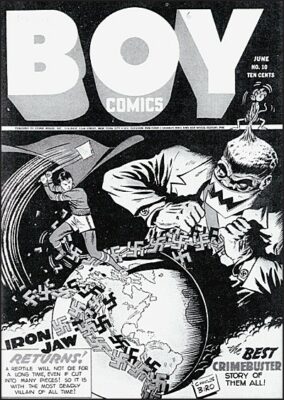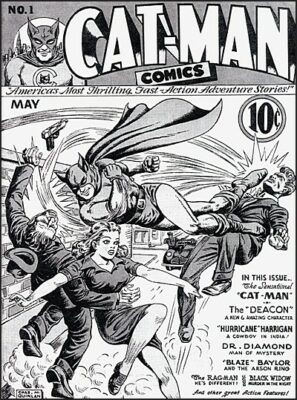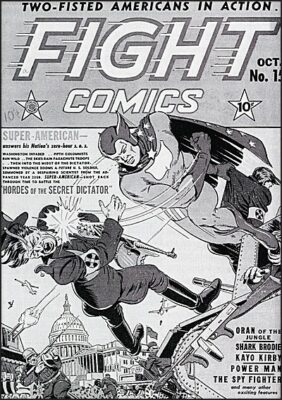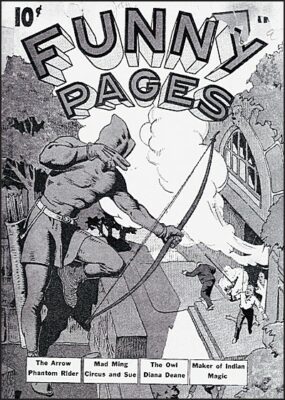Michelle Nolan discusses Secondary Superheroes of the Golden Age by Lou Mougin
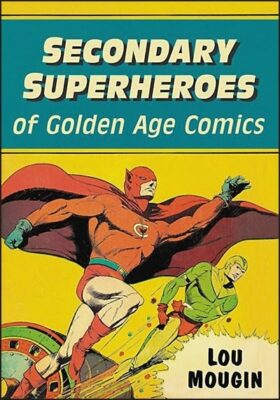
From Michelle Nolan:
When I first met Bud — not long before Jules Feiffer’s iconic “The Great Comic Book Heroes” was published late in 1965 — he was 13 years old and I was 17. We both grew up in San Jose and we both began hunting for old comic books, among other places. from the same used-book store, four years apart when we were in grade school.
What we also both hungered for was knowledge of the characters, of the artists and writers, of the companies that published comic books in what later became known as the Golden Age of 1930s, 1940s and early 1950s.
Knowledge, though, was a virtually impossible comic book commodity in the 1956-1960 period, before DC Comics and then Marvel Comics began tantalizing us with bits of information about what had gone before. The other two major publishers of Golden Age superheroes, Quality Comics and Fawcett Comics, had lasted into the 1950s, leaving collectors like Bud and me with four-color artifacts about Blackhawk and the Marvel Family.
Mougin, however, does a lot more than tantalize us — unless you don’t know much about the remarkably rich history of the Golden Age. Then you may well be basically tantalized enough by the almost overwhelming wealth of information in Mougin’s book to seek out the original comics or at least reprints.
Early in 1965, however, neither Bud nor I were even remotely aware of almost all the dozens upon dozens of characters Mougin covers. It took both of us several years, the better part of a decade, to learn the basic information Mougin presents in one highly informative volume.
Rather than produce a dry, alphabetical compendium, Mougin presents a remarkable amount of information the right way, indeed the best way, while using characters from major publishers DC, Marvel, Quality and Fawcett to provide insightful context.
The first 13 chapters include one chapter each on the definitely secondary but still certainly important companies — Centaur, Fox, Harvey, MLJ, Nedor, Lev Gleason, Novelty, Hillman, Prize, Street & Smith, Columbia, Holyoke, Ace and Chesler.
The 15th chapter is fittingly titled Everybody Else.
Off-hand, I could not find a single super hero ignored from the companies so thoroughly covered in the first 14 chapters. That’s saying something, because I have been among the most avid of comics historians for more than 50 years. And if Lou forgot anyone in Everybody Else, well, I wouldn’t worry about it.
If you read one book on old comic books this year, you could not go wrong with this volume. You will also find compelling the dozens of cover reproductions of comic books most readers will be seeing for the first time.
Mougin begins with an appropriate secondary company, Centaur, because this was the first company to provide competition for National Comics, as DC was generally known when Superman debuted in 1938. As he does throughout the book, Mougin provides the creators, origin, secret identity, powers and abilities, and a few plot points for every superhero and costumed hero. (To put it simply, Superman is a superhero and Batman is a costume hero.)
His writing style is always accessible and concise but sometimes laced with affectionate humor, such as his comment on Amazing Man #5 in 1939 , which was actually the first issue: “Lord only knows where the first four issues went.“ In reality, some titles began with a number other than 1 because the publisher wanted the retailer to feel the title was at least somewhat successful. At other times, to save on the cost of postal mailing permits, a publisher began a new title with the issue number of a discontinued title.
Most Centaur titles and characters appeared only a few times at most. Whereas he goes into depth about Amazing Man, which ran 22 issues from #5-26, he gives many less worthy heroes an appropriate paragraph or two. Had Mougin tried to describe all the superheroes of the era in some depth, the book would have run to more than 1,000 pages!
Mougin’s second chapter covers Fox Comics, which like Centaur vanished in 1942 but unlike Centaur reappeared in 1944, thanks to eccentric owner Victor Fox’s return to civilian life. Fox became known for exotic exploitation in the late 1940s and in 1950, its last full year as a publisher. But in the 1939-1942 period, Fox published some of the most collectible early super hero comics, including flagship titles Mystery Men Comics and Wonderworld Comics, replete with sensational covers.
Mougin displays sound judgment with in-depth coverage of Fox’s primary super hero, the Blue Beetle, who was not really a “secondary superhero.” Neither was the Phantom Lady, described as the “pulchritudinous phantomette,” showing the author’s flair for the well-turned phrase. But they are fittingly included in the book because Mougan could not compellingly title the volume “Secondary Comic Book Companies.”
The Blue Beetle’s own title — taken over by Holyoke Comics during part of World War II before returning to Fox in 1944 — ran from 1939 to 1948 and in 1950 for 60 issues, which was actually one of the longest runs for a superhero published by a secondary company. As Mougin illustrates in detail, Charlton Comics picked up the character for brief appearances in three titles in 1954-1956 before the Blue Beetle seemingly disappeared forever.
When a flurry of smaller companies produced superheroes in the mid-1960s in response to solid Silver Age sales by DC and Marvel, Charlton brought back the Blue Beetle for a few years. As the author does with many characters, he also details how the Blue Beetle appeared in several other publishers’ comics before winding up in the DC stable.
I vividly recall flying back from a trip to Italy in 1964 as a 16-year-old and seeing a youngster reading the first reappearance of Charlton’s Blue Beetle. Borrowing the comic, I was puzzled by this superhero. I thought he was a new creation, since in the eight years I had been a collector by 1964, I had never seen any of his back issues. Finding the adzine Rocket’s Blast-Comic Collector later that year, I began to learn some of the history of these “secondary superheroes,” even when they were not so secondary.
Such a memory makes Mougin’s book especially appealing. And if you are a comic collecting novice, this book will give you the best possible idea about what you might want to collect. Believe me, unless you are a multi-millionaire, you won’t be able to collect everything!
Fox published more than a dozen intriguing superhero strips, including some of the earliest patriotic heroes such as The Eagle, U.S. Jones and V-Man, along with moderately successful strips such as The Flame and Samson. Mougin covers them all well.
Mougin’s third chapter, on Harvey Comics, will surprise anyone who conflates humor for younger readers with Harvey, which is best remembered for the long-running and hugely successful likes of Richie Rich, Casper the Friendly Ghost, Little Dot and Sad Sack. Harvey was among the most successful publishers from the 1950s through the 1970s but Mougin reveals in great detail how successful the firm was with superheroes like the Green Hornet, Black Cat and Shock Gibson in the 1940s.
Some of the best artists of the Golden Age, such as the Simon & Kirby team, Bob Powell and Lee Elias, worked on early superhero strips for Harvey. But Like Centaur and Fox, Harvey’s heroes were seldom seen in the world of back issues until the late 1960s and early 1970. One of my regrets as a collector was that I did not seek out as many Harvey superhero issues as I should have until collectors began to recognize their quality and their prices took an appropriate jump. Had I had a fact-filled book like “Secondary Superheroes,” I would not have made that mistake!
Chapter 4 covers MLJ Comics, which became the Archie Series shortly after World War II ended. MLJ is probably the most successful company covered in “Secondary Superheroes,” yet was not nearly as successful as the Big Four of National, Marvel, Fawcett and Quality. Back issues of MLJ Comics were not nearly as plentiful as those of the Big Four when collectors began to get curious about colorful heroes such as The Shield, Black Hood and Steel Sterling, among more than a dozen Golden Age worthies. MLJ did get an early publicity boost in 1969, when I published an issue-by-issue index of this intriguing company’s comics with superheroes from 1939 to 1948.
Although more has been written about MLJ than any other company in this book, Mougin’s detailed plot summaries and character surveys will likely teach any Golden Age collector something new. The 54-page chapter is one of the most comprehensive surveys ever done on this company.
Chapter 5 is dear to my heart, covering the company commonly known as Nedor Comics, which is actually one of the sub-publishers used by Ned Pines, who was among the leading paperback and pulp publishers for many years. In 1968, Nedor became the company I chose for the first of my three issue-by-issue indexes of Golden Age companies (the others were MLJ and Timely (later Marvel). They were the first issue-by-issue superhero indexes and Mougin’s chapter on Nedor will tell you why I chose that company.
Best known for the Black Terror and the Fighting Yank, almost all of Nedor’s covers were masterpieces of frenetic, detailed action by Alex Schomburg, who also worked extensively on covers for Timely and Harvey. As the book points out, the interior art generally did not come close to matching the covers. Indeed, in some ways Nedor published the most generic of superhero stories. Mougin, though, makes the characters come alive with vivid descriptions of their adventures.
One of my favorite Golden Age companies, Lev Gleason Comics, is lovingly detailed in Chapter 6. Although characters like Silver Streak and Pat Patriot provide colorful examples of early Golden Age storytelling, Mougin shows why Daredevil and Crimebuster had their own best-selling titles for a long time.
Mostly written by Gleason editor Charles Biro, Chuck Chandler (Crimebuster) in Boy Comics along with Daredevil and his kid gang, The Little Wise Guys, in Daredevil Comics were vividly portrayed in what Mougin shows to be some of the goriest superhero stories of the Golden Age. But after World War II, Crimebuster and Daredevil each spent several years starring in possibly the most socially responsible of all hero stories, taking on conditions that spurred crime and juvenile delinquency.
Daredevil and Crimebuster consistently appeared in some of the longest, most detailed stories on offer in the Golden Age. Unlike almost al the heroes featured by the companies in “Secondary Superheroes,” Daredevil and Crimebuster appealed to so many readers that their back issues did pop up frequently in the late 1950s and early 1960s. Gleason and Biro openly boasted on their late 1940s covers about the millions of readers they had in Daredevil, Boy and their other best-seller, Crime Does Not Pay.
The companies spotlighted in the second half of the book were all much lesser known in the comics world than those in the first six chapters, but that doesn’t stop Mougin from providing details many readers will encounter for the first time. These are Novelty Comics (Chapter 7), Hillman Comics (Chapter 8), Prize Comics (Chapter 9), Street & Smith Comics (Chapter 10), Columbia Comics (Chapter 11), Holyoke Comics (Chapter 12), Ace Comics (Chapter 13) and Chesler Comics (Chapter 14).
By far the best known character to be featured by any of these companies was The Shadow in his 107-issue run for Street & Smith, which was much better known as the era’s leading pulp publisher. But each company produced successful characters, including Blue Bolt and Spacehawk (Novelty), Airboy (Hillman), Black Owl (Prize), Skyman (Columbia), Catman (Holyoke), Magno and Flash Lightning (Ace) and Dynamic Man (Chesler).
Mougin will help you understand why there are collectors today who seek out complete runs of characters like Airboy, Catman and Skyman. (If I tried, this review would easily exceed 10,000 words. But then, that’s why you need this book, if you care at all about Golden Age heroes.
Chapter 15, “Everybody Else,” contains information it took me years and years to acquire. Most of the characters featured appeared briefly, but that just adds to their intrigue. Complete accounts appear for the generally little-known superheroes from Fiction House, Rural Home, Dell, Eastern and much lesser-known companies.
Michelle Nolan is the author of “Love on the Racks: A History of American Romance Comics” and the upcoming “Archie’s Rivals: Teens in Comics 1940s-1970s,” both from McFarland. She has been a comics historian for more than 50 years and holds an Inkpot Award from Comic-Con International: San Diego.
Copy From Bud Plant:
Highly Recommended. By Lou Mougin. When Superman debuted in 1938, he ushered in the superhero—Batman, Wonder Woman, Captain Marvel, Captain America, hundreds of new characters. But what about the many less well-known heroes who lined up to fight crooks, super villains and Hitler? Such as the Shield, the Black Terror, the Golden Age Daredevil, Amazing Man, Cat-Man (and Kitten), Dynamic Man, the Blue Beetle, the Hollywood starlet turned crime fighter The Black Cat? Publisher by publisher, this well-respected author covers in detail 14 offbeat outfits including Centaur, Fox, Prize, Ace, Harvey, Hillman, MLJ, Nedor (Standard), Lev Gleason, etc. Each unique character is examined, even if they made just a solo appearance.
Most have since been overlooked, and not necessarily because they were victims of poor publication. This book gives the other superheroes of the Golden Age of comics their due, with a blow-by-blow look at each one’s career and creators, context and oddities.
Other publishers who rate their own chapter: Novelty, Street and Smith, Columbia, Holyoke, Chesler, plus a chapter on everyone else. These guys published such notable titles as Big Shot, The Face, Skyman, The Shadow, Doc Savage, Super-Magician, Captain Aero (by Charles Quinlain), Blue Bolt (by Simon & Kirby) and on and on.
Nearly 450 pages long, this is massive and thorough.
Lou is a comics writer, historian and interviewer with credits at Marvel, Heroic, Claypool, Warrant, Charlton and others. He’s extremely knowledgeable and writes with good humor, making this easy to read. Issue by issue, character by character, he takes us from first issues to (sometimes much later) origins, and even post-Golden Age appearances up to the present day. This is not a history of each company and its inner workings, rise and fall. This is about the heroes and heroines, and the men and women who wrote and drew them. Lou’s critiques are right-on, as he points out good stories and artwork, vs more forgettable works.
Publisher McFarland has gotten better of late with their high prices, but not so here. $75 really put me off, until I actually saw a copy. This is definitely a major book. And although it has no interior color, it has nice large cover reproductions of many of the titles mentioned, more than in other McFarland books. I’ve just started reading it and I’m already quite happy with it, after just the first chapter (on Centaur).
Lou points out in his introduction that he’d waited years for a book like this, but no one stepped up to the plate. So he did, and I think he’s done a superlative job here. As a fan of all these offbeat Golden Age companies, I think it’s worth the price of admission.
Sincerely,
Bud Plant
Former distributor and publisher
Currently head of Buds Art Books
Trusted Comics Dealer
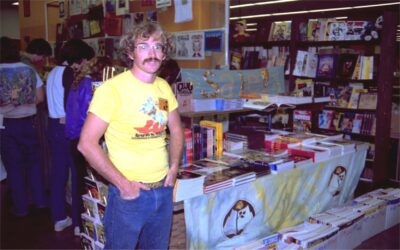
Join us for more discussion at our Facebook group
check out our CBH documentary videos on our CBH Youtube Channel
get some historic comic book shirts, pillows, etc at CBH Merchandise
check out our CBH Podcast available on Apple Podcasts, Google PlayerFM and Stitcher.
Use of images are not intended to infringe on copyright, but merely used for academic purpose.









